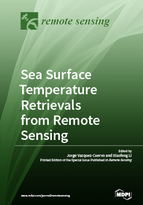Sea Surface Temperature Retrievals from Remote Sensing
A special issue of Remote Sensing (ISSN 2072-4292). This special issue belongs to the section "Ocean Remote Sensing".
Deadline for manuscript submissions: closed (20 November 2017) | Viewed by 154807
Special Issue Editors
Interests: validation of remote sensing data; application of remote sensing to coastal regions; development of new remote sensing for high resolution; validation of remote sensing data sets in challenging areas, including the arctic and coastal regions
Special Issues, Collections and Topics in MDPI journals
Interests: AI oceanography; big data; ocean remote sensing; physical oceanography; boundary layer meteorology; synthetic aperture radar imaging mechanism; multiple-polarization radar applications; satellite image classification and segmentation
Special Issues, Collections and Topics in MDPI journals
Special Issue Information
Dear Colleagues,
We are actively seeking contributions to a Special Issue of Remote Sensing on “Sea Surface Temperature (SST) Retrievals from Remote Sensing." SSTs are currently retrieved from infrared sensors on both polar orbiting and geostationary platforms, as well as from microwave sensors. Infrared sensors have the advantage of retrievals at higher resolutions, but are limited to cloud free conditions, while microwave sensors are lower resolution, but essentially provide all weather retrievals. Geostationary satellites have the advantage of essentially viewing the same area on the Earth continuously, thus improving coverage.
Overview papers that address the current state of SST retrievals, from both infrared and microwave sensors, are encouraged. SST sensors, such as the Visible Infrared Imaging Radiometer Suite (VIIRS), provide, for the first time, a sub-kilometer resolution. Papers that address the accuracy of SST retrievals at these higher resolutions are encouraged.
Another important area is the application of quality information to SST retrievals. Papers that address, especially in coastal areas, the impact of quality flags on accuracy and coverage are also encouraged.
Thank you in advance for your consideration of a timely and important contribution to our state of knowledge of SST retrievals from satellites.
Dr. Jorge Vazquez
Dr. Xiaofeng Li
Guest Editors
Manuscript Submission Information
Manuscripts should be submitted online at www.mdpi.com by registering and logging in to this website. Once you are registered, click here to go to the submission form. Manuscripts can be submitted until the deadline. All submissions that pass pre-check are peer-reviewed. Accepted papers will be published continuously in the journal (as soon as accepted) and will be listed together on the special issue website. Research articles, review articles as well as short communications are invited. For planned papers, a title and short abstract (about 100 words) can be sent to the Editorial Office for announcement on this website.
Submitted manuscripts should not have been published previously, nor be under consideration for publication elsewhere (except conference proceedings papers). All manuscripts are thoroughly refereed through a single-blind peer-review process. A guide for authors and other relevant information for submission of manuscripts is available on the Instructions for Authors page. Remote Sensing is an international peer-reviewed open access semimonthly journal published by MDPI.
Please visit the Instructions for Authors page before submitting a manuscript. The Article Processing Charge (APC) for publication in this open access journal is 2700 CHF (Swiss Francs). Submitted papers should be well formatted and use good English. Authors may use MDPI's English editing service prior to publication or during author revisions.
Keywords
- Remote Sensing
- Sea Surface Temperature
- Infrared
- Microwave
- Accuracy







